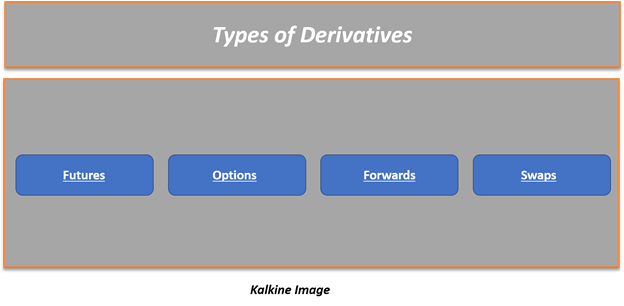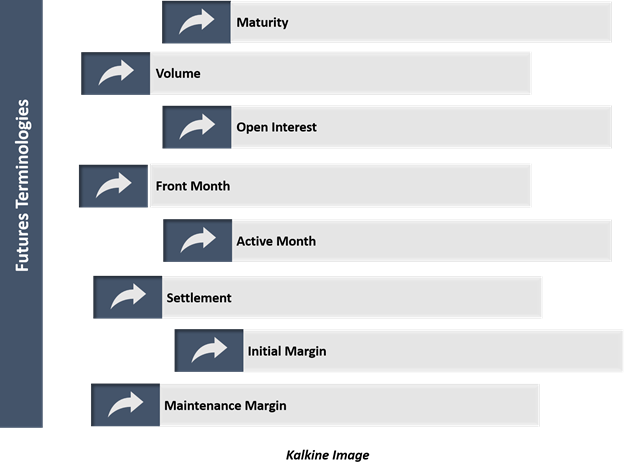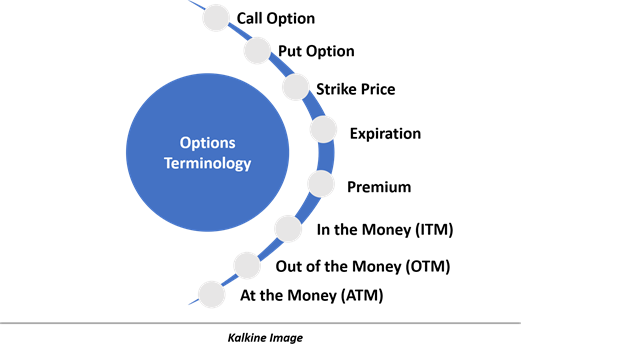Definition
Related Definitions
Derivatives
Definition- Derivatives
Derivates are defined as a legal contract between two parties to transact a financial instrument at a future date but with a pre-determined price.
The value of a derivative is ideally linked to the value of the primary security or the underlying security, which could be a currency, stock, commodity, or security that bears interest.
Types of Derivatives
Derivatives, which are also a type of structured products, have evolved over the years, and at present, there are mainly four major types of derivatives.

Futures
Futures are contracts to buy or sell a specific quantity of the underlying financial instrument for delivery in the future dates. Originally designed to reduce the unsystematic risk or the market risk, such contracts now also allow investors or traders, to lock-in prices in the future.
Watch: What are Futures in Stock Market?
- Benefits and Uses
Futures are standardised contracts that trade freely on exchanges while maintaining a clearing system, which guarantees the trades.
Futures provide benefit to both commercial producer and consumers while mitigating counterparty risk, which is one of the inherent features of derivatives.
For commercial producers, futures contract allows them to lock-in a present price on their future sales, and by the same token allow them to know the price they would receive on their production. Likewise, a futures contract allows the consumer to estimate their cost of consumption in the future.
For example, let us assume an airline, based on some assumptions, believes that the oil price, which is one of its highest costs, would be higher three months later down the line as compared to the present level.
Thus, the airline company would be more likely to enter a futures contract of crude oil, which though is not the direct fuel input into jets, but jet fuels are derived from crude oil- allowing the airline to assess the cost of its future operations.
Likewise, for a crude oil producer, the same contract would allow them to know the price they would receive on their future sales.
Apart from the typical use of futures contracts, such structured products allow investors to participate in the price rally of an the underlying financial product.
Investors and speculators typically enter futures based on their assessment of the future movement in the contract, which rarely leads into delivery – a phase of futures contract closure.
Good read: Understanding Future Derivatives and Participants of Derivatives
- Futures Terminologies

Maturity – The date when a futures contract ceases trading or cease to exist in the marketplace and get replaced with a future contract of far expiry.
Volume – The number of contracts traded in a given time period.
Open Interest – The number of futures contracts outstanding for delivery in each expiry.
Front Month – The nearest delivery month. Also referred to as spot month or nearby month.
Active Month – It is typically the month of the highest volume and open interest and is usually the front-month; however, an active month often changes ahead of expiry.
Settlement – It is the settlement of the contract, which either happens on the basis of underlying financial instrument or cash.
Initial Margin – Unlike the spot market, futures contract does not require an upfront payment for entering the trade. The initial margin is ideally a percentage determined by an exchange of the total value of the futures contract, which needs to be submitted in the trading account to enter a futures contract.
Maintenance Margin – During its tenure till expiry, a futures contract fluctuates or changes price, depending upon the demand and supply dynamics, which leads to a change in the total value of the contract. A maintenance margin is a margin required to keep a future position open until expiry if the total value of the contract changes.
This margin is typically decided by the broker, who provides leverage for future trading. Also, a maintenance margin requirement reduces the counterparty risk by prompting the parties to deposit the possible amount of default ahead of closing a position.
Options
Options contracts or simply options are contracts which unlike futures give the holder a right but not the obligation to buy or sell a specific amount of the underlying financial instruments.
As options do not impose any obligation on the buyer to meet the commitments of the agreement, it calls for a premium, i.e., an amount or price for selling the right of performance to the other party.
In the options market, these premiums are a freely tradable instrument, which investors or traders use for speculation purposes.
The major benefit of options is the leverage it provides to low net-worth investors or the opportunity it provides to a retail investor, to participate in the price rally of an underlying security at a low initial cost, as premium prices are directly correlated to the price movement of the underlying financial instrument.
Apart from speculation, mainly options contract is used for hedging purpose, as it allows the counterparty to purchase an underlying security at a pre-determined price in the future day by paying a premium.
Do read: Equity Options: 5 reasons These can Bring a Change to your Investment Strategy
- Types of Options
There are broadly two types of options, i.e., American style and European style.
An American style option is an option that may be exercised at any time up to and including their expiration date.
A European style option is an option that may be exercised only at expiration.
- Options Terminology

Call Option – A call option gives the holder (call buyer) a right to buy a defined amount of the underlying security at a certain price and on a certain date by paying a premium to the call seller.
Put Option – A put option gives the holder (put buyer) a right to sell a defined amount of the underlying security at a certain price and on a certain date to the put seller by paying a premium.
In a typical day of the transaction, an option buyer pays a premium, and an option seller receives premium, which is the case of both call and put options.
Strike Price – The strike price is defined as the price at which an option holder may want to buy or sell an underlying security. For example, a call option with a strike price of 100 gives the call buyer a right to purchase the underlying security at 100 from the call seller at a pre-determined date, irrespective of the market price of the underlying security.
Expiration – The date at which the option buyer no longer has the right to exercise.
Premium – The price paid for the right by the option buyer or the price received by the option seller for selling the right to exercise the option to the option buyer.
In the Money (ITM) – A call option with the strike price below the market price of the underlying security or a put option with a strike price above the market price of the underlying security.
Out of the Money (OTM) – A call option with a strike price above the market price of the underlying security or a put option with the strike price below the market price of the underlying security.
At the Money (ATM) – An option with a strike price at or very close to the market price of the underlying security.
Typically, option prices contain both an intrinsic value and a time value which could be gauged upon by understanding options models such as black-Scholes model and options geeks, i.e., Delta, Gamma, Vega, Theta, and Rho.
Read: Guide To Vanilla Options And Its Types
Forwards
Just like futures, a forward contract, often shortened to just forward, is a contract between two parties to buy or sell an asset at a specific price on a specified date in future.
However, unlike futures, forwards do not typically trade over exchanges and are ideally an instrument of over-the-counter (OTC) market. Also, forward contracts are more of a personal agreement between two parties that is not standardised, i.e., it allows both parties to choose basic attributes of derivatives such as quantity, expiration, date, amount.
Unlike, futures, forwards do hold counterparty risk, i.e., the risk that one of the party in an agreement would default in the case of an extreme price move in an underlying asset, as it is not backed by a clearing system.
Good read: Understanding Forward Derivatives and the Associated Risks
Swaps
Swaps are another type of derivatives that allow two or more parties to exchange their cash flows/ revenue stream or liabilities from two different financial assets.
Swaps are broadly classified into three categories, i.e., interest rate swaps, currency swaps, and hybrid swaps.
- Interest Rate Swaps – It allows two parties to swap financial flow associated with two distinct debt instruments.
- Currency Swaps – It allows two parties to swap or exchange financial flow associated with two distinct currencies.
- Hybrid Swaps – It allows two parties to exchange financial flow associated with distinct debt instruments denominated in different currencies.
Must read: A Flick Through Modern Derivatives: Swaps
